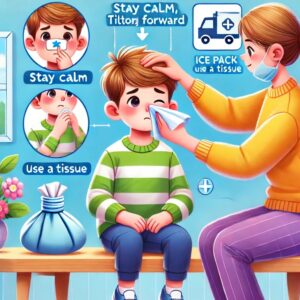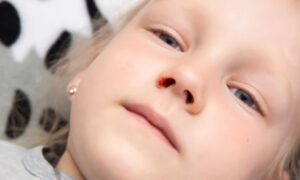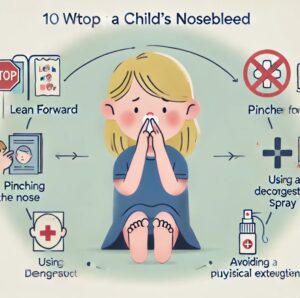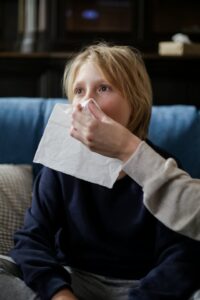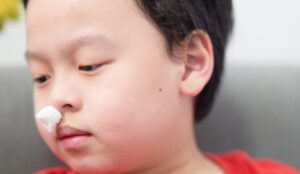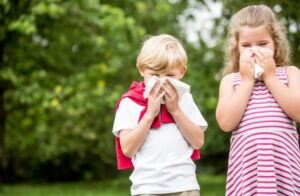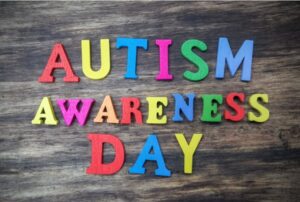What Is Nose Bleeds?
Nosebleeds (also known as epistaxis) are common among children, and while they are usually not serious, they can cause anxiety for both kids and parents. Understanding the causes, symptoms, and treatment options can help you manage nosebleeds effectively. In most cases, with simple home treatment, nosebleeds can be controlled.
What Causes Nosebleeds in Children?
Nosebleeds in children are quite common, especially between the ages of 2 and 10. Over 50% of children have experienced at least one nosebleed before reaching the age of 10. Several factors contribute to the occurrence of nosebleeds, including:
- Dry Air: Dry indoor air, particularly during winter months or in heated homes, is one of the most common causes of nosebleeds in children. Low humidity can dry out and irritate the nasal membranes.
- Nasal Inflammation: Allergies such as allergic rhinitis or sinus infections can cause swelling and irritation of the nasal passages, making the blood vessels more fragile and prone to bleeding.
- Nasal Trauma: Children often engage in rough play, or they may pick their noses, which can cause small injuries to the delicate blood vessels inside the nose.
- Foreign Objects: Kids may insert small objects into their noses, irritating the nasal mucosa and leading to frequent nosebleeds.
- Medication Side Effects: Certain medications, like blood thinners, can increase the risk of nosebleeds.
- Frequent Forceful Nose Blowing: Forceful blowing of the nose can disrupt the delicate blood vessels inside the nostrils and lead to bleeding.
What Are the Symptoms of Nosebleeds?
In most cases, the main symptom of a nosebleed is blood flow from the nostrils. There are two types of nosebleeds:
Posterior nosebleeds (back of the nose): These may cause blood to flow down the back of the throat, leading to nausea or an unpleasant taste.
Anterior nosebleeds (front of the nose): These are the most common and usually cause visible blood flow from the nostrils.
How to Treat Nosebleeds in Children?
While most nosebleeds are not dangerous, it's important to handle them correctly. Here are some simple steps for treating a child's nosebleed:
- Stay Calm: Keep both yourself and your child calm. Anxiety can make the situation worse.
- Positioning: Have your child sit or stand upright and lean slightly forward to prevent blood from flowing into the throat.
- Pinch the Nose: Pinch the nostrils together gently for 5-10 minutes. This applies pressure on the bleeding site and helps stop the flow of blood.
- Mouth Breathing: Encourage your child to breathe through their mouth while keeping their nose pinched. This helps create pressure and stops the bleeding.
- Cold Compress: Apply a cold compress to the nose or back of the neck to constrict the blood vessels and slow bleeding.
- Avoid Blowing the Nose: After the bleeding stops, avoid having your child blow their nose, as it may restart the bleeding.
For recurrent nosebleeds, use a saline nasal spray to keep the nasal passages moist or a humidifier in the child’s room to maintain proper moisture levels in the air.
When to Seek Medical Attention for a Child’s Nosebleed?
Although most nosebleeds can be treated at home, there are situations where you should consult a doctor:
Bleeding from Multiple Areas: If your child shows signs of bleeding elsewhere, such as from the gums, skin bruising, or black stools.lex, remember to seek medical attention promptly because the health of the child is always the most important.
Frequent Nosebleeds: If your child experiences nosebleeds more than three times a week for over three consecutive weeks.
Prolonged Bleeding: If bleeding lasts for more than 30 minutes despite applying pressure and using other home remedies.
Excessive Bleeding: If the bleeding is so severe that it interferes with your child’s breathing or they feel faint or weak.
Nosebleeds in Very Young Children: If your child is under 2 years old and experiences a nosebleed, seek medical attention.
How to Prevent Nosebleeds in Children?
Prevention is key when it comes to reducing the frequency of nosebleeds. Here are some helpful tips:
Provide Proper Nutrition: A diet rich in vitamins C and K can help strengthen blood vessel walls and reduce the risk of nosebleeds.
Maintain Humidity: Use a humidifier to keep the air moist, especially in dry seasons or in air-conditioned spaces.
Teach Good Habits: Encourage your child not to pick their nose or blow it too forcefully.
Ensure Proper Hydration: Make sure your child stays hydrated to maintain healthy nasal passages.
Key Takeaways
- Nosebleeds are common in children, especially during dry seasons or when they engage in activities like nose picking or rough play.
- Most nosebleeds are not serious and can be treated with simple first aid techniques like pinching the nose and applying a cold compress.
- If nosebleeds become frequent or last longer than expected, seek medical attention.
Frequently Asked Questions (FAQs)
1. How long does a nosebleed last in children? Most nosebleeds in children last between 5-10 minutes. If the bleeding persists beyond 20 minutes, you should seek medical advice.
2. Can a nosebleed be a sign of something serious? In most cases, nosebleeds are not serious. However, if the bleeding is frequent, persistent, or accompanied by other symptoms like bruising, it may indicate an underlying condition, such as a blood disorder.
3. What should I do if my child’s nosebleed doesn't stop after 30 minutes? If the bleeding doesn't stop after 30 minutes of applying pressure, seek medical attention immediately. You may need to visit a doctor for more advanced treatment.
4. How can I stop my child from getting frequent nosebleeds? Keep the air in your home moist using a humidifier, ensure your child avoids nose picking, and use saline nasal spray to prevent dryness in the nasal passages.
5. Can nosebleeds occur because of allergies? Yes, allergies such as allergic rhinitis can cause inflammation in the nasal passages, which can increase the likelihood of nosebleeds in children.
References:
- Johns Hopkins Medicine. (2023). "Nosebleeds." Retrieved from https://www.hopkinsmedicine.org/health/conditions-and-diseases/nosebleeds
- Di Cicco, M., Kantar, A., Masini, B., Nuzzi, G., Ragazzo, V., & Peroni, D. (2020). Structural and Functional Development in Airways Throughout Childhood: Children are Not Small Adults. Pediatric Pulmonology. doi:10.1002/ppul.24677.
- Cleveland Clinic. (2023). "Nosebleed (Epistaxis)." Retrieved from https://my.clevelandclinic.org/health/diseases/13464-nosebleed-epistaxis
- Mayo Clinic. (2023). "Nosebleeds." Retrieved from https://www.mayoclinic.org/symptoms/nosebleeds/sym-20050856




